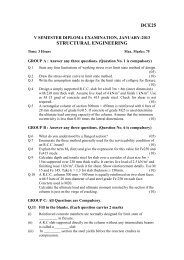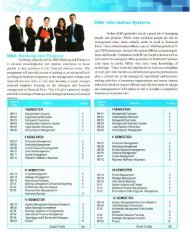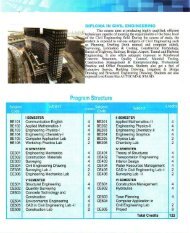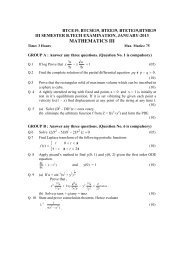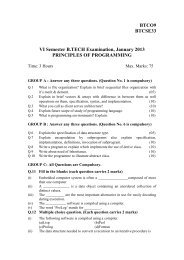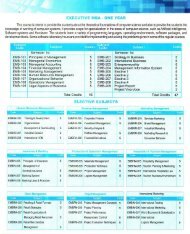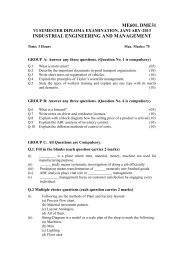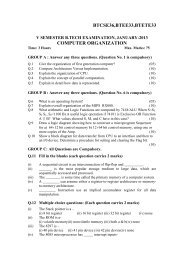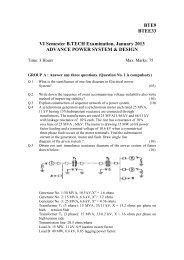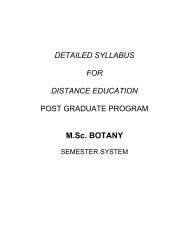MBA in Project Management
MBA in Project Management
MBA in Project Management
You also want an ePaper? Increase the reach of your titles
YUMPU automatically turns print PDFs into web optimized ePapers that Google loves.
<strong>MBA</strong>-<strong>Project</strong> <strong>Management</strong>The objective of this course is to <strong>in</strong>troduce models and concepts that provide <strong>in</strong>sightson a wide range of managerial problems. Qualitative and quantitative methods will be used toaddress various aspects of manag<strong>in</strong>g a bus<strong>in</strong>ess concern. Major topics <strong>in</strong>clude ethics andcorporate social responsibility, organizational design, plann<strong>in</strong>g and strategy formulation,motivation, reward and discipl<strong>in</strong>e. It focuses on project management tools and techniques fordef<strong>in</strong><strong>in</strong>g and manag<strong>in</strong>g the project's goal, scope, schedule, and budget.SubjectCodeSubjectCreditsSubjectCodeSubjectCreditsSEMESTER ISEMESTER III<strong>MBA</strong>-01<strong>MBA</strong>-02<strong>MBA</strong>-03<strong>MBA</strong>-04<strong>MBA</strong>-05<strong>MBA</strong>-06Managerial Tasks andBehavioural DynamicsCorporate Communication andManagerial EconomicsLegislative Framework ofBus<strong>in</strong>essAccount<strong>in</strong>g and Taxation forManagersQuantitative Techniques forManagerial DecisionsBus<strong>in</strong>ess Development andEntrepreneurship5 <strong>MBA</strong>-13 Research Methodology 55 <strong>MBA</strong>-14 Total Quality <strong>Management</strong> 55 <strong>MBA</strong>-155 PM-01International Bus<strong>in</strong>ess<strong>Management</strong><strong>Project</strong> Plann<strong>in</strong>g AndExecution5 PM-02 <strong>Project</strong> Control System 55 PM-03 <strong>Project</strong> Support System 555SEMESTER IISEMESTER IV<strong>MBA</strong>-07<strong>MBA</strong>-08Human Asset <strong>Management</strong>Corporate F<strong>in</strong>ance and Services5 PM-04 <strong>Project</strong> Exports 55 PM-05<strong>Project</strong> F<strong>in</strong>ancial<strong>Management</strong>5<strong>MBA</strong>-09Market<strong>in</strong>g Plann<strong>in</strong>g and<strong>Management</strong>5 PM-06<strong>Project</strong> Risk & Team<strong>Management</strong>5<strong>MBA</strong>-10Production Technology andIndustrial Eng<strong>in</strong>eer<strong>in</strong>g5 PM-07E-Commerce Application In<strong>Project</strong> <strong>Management</strong>5<strong>MBA</strong>-11Information Science forManagers5 PM-08Small Bus<strong>in</strong>ess <strong>Management</strong>5<strong>MBA</strong>-12Strategic <strong>Management</strong> andCorporate Governance5 <strong>MBA</strong>-16<strong>Project</strong> WorkViva voice63Grand Credits 124
SUBJECT CODE: <strong>MBA</strong>-01SUBJECT: MANAGERIAL TASKS AND BEHAVIOURAL DYNAMICSThis course helps to prepare the students to understand the basic application of managerialfunctions <strong>in</strong> day to day operations and activities of corporate and bus<strong>in</strong>ess enterprises.OBJECTIVES:1. To understand the role and responsibilities of manager2. To learn the process of management <strong>in</strong> corporate enterprises.3. To comprehend the behavior of others and adapt to managerial success.4. To make the students to equip the necessary changes and developments <strong>in</strong> an organization.STRUCTURE OF THE COURSE CONTENTBLOCK 1 MANAGERIAL FUNCTION AND RESPONSIBILITIESUnit 1: Manager Role, Responsibilities and TasksUnit 2: Managerial Functions and Their CharacteristicsUnit 3: Evolution of <strong>Management</strong> and Schools of ThoughtUnit 4: Social Responsibilities and Bus<strong>in</strong>ess Ethics & Corporate GovernanceBLOCK 2 PLANNING AND ORGANIZING FUNCTIONUnit 1: Plann<strong>in</strong>g Nature, Types and ProcessUnit 2: Decision Mak<strong>in</strong>g and MBOUnit 3: Organiz<strong>in</strong>g Pr<strong>in</strong>ciples and Structural DesignUnit 4: Delegation, Span of Control, Decentralization, L<strong>in</strong>e and Staff AuthorityBLOCK 3 DIRECTING, CONTROLLING AND CO ORDINATIONUnit 1: Direct<strong>in</strong>g, Motivat<strong>in</strong>g, And LeadershipUnit 2: Controll<strong>in</strong>g Nature and TechniquesUnit 3: Co Ord<strong>in</strong>ation the Essence of <strong>Management</strong>Unit 4: Contemporary Trends <strong>in</strong> <strong>Management</strong>BLOCK 4 INTRODUCTIONS TO BEHAVIOURAL DYNAMICSUnit 1: Evolution, Challenges and Opportunities of Organization BehaviourUnit 2: Personality and Behavioural AssessmentUnit 3: Emotions and Learn<strong>in</strong>gUnit 4: Perceptions and Stress <strong>Management</strong>
BLOCK 5 ORGANIZATIONAL BEHAVIOURAL DYNAMICSUnit 1: Change <strong>Management</strong>Unit 2: Organizational ClimateUnit 3: <strong>Management</strong> of ConflictsUnit 4: Organizational Development InterventionsREFERENCE BOOKS:1. Peter F Druker, <strong>Management</strong> Tasks and Responsibilities, Truman Talley Books, New York.2. Stephen P Robb<strong>in</strong>s, Fundamental of <strong>Management</strong>, Pearson 20033. Koontz & Weirich, Essentials of <strong>Management</strong>, Tata McGraw Hill, New Delhi4. Stephen P Robb<strong>in</strong>s, Organization Behaviour, Prentice Hall Of India, 6 th Edition5. C B Gupta, <strong>Management</strong> Pr<strong>in</strong>ciples And Practice, Sultan Chand & Sons, New Delhi6. L M Prasad, Organization Behaviour, Sultan Chand & Sons, New Delhi7. Consumer Behaviour- Leon Schiffman, Lesslie Lazar Kanuk-Pearson/PHI,8/E8. Consumer Behaviour- Hawk<strong>in</strong>s, Best, Coney-TMH,9/e,20049. Consumer Behaviour <strong>in</strong> Indian Perspective – Suja Nair – Himalaya Publishers, 200410. Consumer Behaviour- Satish k Batra & S H H Kazmi, Excell Books11. Customer Relationship <strong>Management</strong>- Peeru Ahamed & Sagadevan Vikas Publish<strong>in</strong>g
SUBJECT CODE: <strong>MBA</strong>-02SUBJECT: CORPORATE COMMUNICATION AND MANAGERIAL ECONOMICSThis course enables the students to develop their communication and analytical abilities <strong>in</strong>terms of effective presentation and economic uncerta<strong>in</strong>ties by apply<strong>in</strong>g modern and contemporarytools and techniques for competitive advantage.OBJECTIVES1. To adopt the modern application of communication and presentation of ideas2. To understand the basic pr<strong>in</strong>ciples of effective correspondence and idea generation.3. To make the decision and evaluation through application of economic tools and techniques.4. To equip and adapt the chang<strong>in</strong>g and challeng<strong>in</strong>g environmental threats and opportunities.STRUCTURE OF THE COURSE CONTENTBLOCK 1 CONCEPT OF CORPORATE COMMUNICATIONUnit 1: Mean<strong>in</strong>g Importance Pr<strong>in</strong>ciples and Objectives OfCommunicationUnit 2: Verbal and Non Verbal CommunicationUnit 3: Speech & Technical and Non Technical PresentationUnit 4: Group Discussion, Conference and InterviewTechniquesBLOCK 2 APPLICATION OF COMMUNICATION IN BUSINESSUnit 1: Bus<strong>in</strong>ess Letters: Concept And IntroductionUnit 2: Inquiries, Circulars, Quotation, Order, andAcknowledgementUnit 3: Compla<strong>in</strong>ts, Collection, Memos, M<strong>in</strong>utes and ResumePreparationUnit 4: Bank<strong>in</strong>g, Insurance, and Sales CorrespondencesBLOCK 3 INTRODUCTIONS TO MANAGERIAL ECONOMICSUnit 1: Managerial Economics Role and ResponsibilitiesUnit 2: Law of Demand and Elasticity Of DemandUnit 3: Utility Analysis and Indifference CurveUnit 4: Demand Forecast<strong>in</strong>g and Demand Dist<strong>in</strong>ctionsBLOCK 4PRODUCTIONS, COST AND MARKET STRUCTUREUnit 1: Production Functions and Laws of Returns
Unit 2: Cost Functions and Marg<strong>in</strong>al Cost TheoryUnit 3: Market Structure and Price Determ<strong>in</strong>ationUnit 4: Pric<strong>in</strong>g Strategies and TechniquesBLOCK 5 ENVIRONMENTAL ASSESSMENTS AND DIAGNOSISUnit 1: Corporate Environment and AssessmentUnit 2: Indian Economic EnvironmentUnit 3: International Trade and TrendsUnit 4: Money, Bank<strong>in</strong>g, Inflation and Bus<strong>in</strong>ess CyclesREFERENCE BOOKS1. Rajendrapal, Korlahalli, Essentials of Bus<strong>in</strong>ess Communication, Sultan Chand & Sons,New Delhi,2. Peterson Lewis, Managerial Economics, Prentice Hall of India, New Delhi, 20023. Varshney & K L Maheshwari, Managerial Economics, Sultan Chand & Sons, New Delhi4. N S Raghunathan & B Santhanam, Bus<strong>in</strong>ess Communication, Margham Publication,Chennai.5. Bus<strong>in</strong>ess Communication - Asha Kaul (2000), New Delhi, Prentice Hall of India6. Effective Bus<strong>in</strong>ess Communication - Murphy and Hildebrandt (1991),New York: McGraw Hill7. Communication <strong>in</strong> India : Some Observations and Theoreticalimplications - J.S. Yadava, IIMC8. Communication Theory: Eastern and Western perspective- Lawrence D.
SUBJECT CODE: <strong>MBA</strong>-03SUBJECT: LEGISLATIVE FRAMEWORK OF BUSINESSThis course presents the rules and conduct of bus<strong>in</strong>ess <strong>in</strong> terms of legislative framework. Thisstudy helps the manager to lead the bus<strong>in</strong>ess <strong>in</strong> a smooth and orderly manner as per the legalprescription by the Indian Government.OBJECTIVES1. To understand the nature of laws govern<strong>in</strong>g the Indian bus<strong>in</strong>ess.2. To understand the economic and labour laws perta<strong>in</strong><strong>in</strong>g to corporate perspectives.3. To govern the bus<strong>in</strong>ess as per the legislative requirements.4. To exam<strong>in</strong>e the recent requirements of the government from the bus<strong>in</strong>ess.STRUCTURE OF THE COURSE CONTENTBLOCK 1ELEMENTS OF BUSINESS LEGISLATIONUnit 1: The Contract Act 1872, And Their Special ContractsUnit 2: Indian Partnership Act 1932Unit 3: Sale of Goods Act 1930Unit 4: Negotiable Instruments Act 1881BLOCK 2 ELEMENTS OF ECONOMICS LEGISLATIONUnit 1: Information Technology Act 2000Unit 2: The Consumer Protection Act 1986Unit 3: The Environment Protection Act 1986Unit 4: Competition Law 2002Unit 5: Intellectual Property Tax LawsBLOCK 3 BANKING AND INSURANCE LAWSUnit 1: The Bank<strong>in</strong>g Regulation Act 1949Unit 2: The Reserve Bank of India Act 1934Unit 3: The Insurance Act and IRDA RegulationsBLOCK 4LABOUR LEGISLATIONUnit 1: Factories Act 1948 & Workmen Compensation Act 1923
Unit 2: Employee State Insurance Act 1948 & EPF and MiscellaneousProvisio`n Act 1952Unit 3: Industrial Disputes Act 1947 & Trade Union Act 1926Unit 4: The M<strong>in</strong>imum Wages Act 1948 & the Payment of Wages Act 1936Unit 5: The Payment Of Bonus Act 1965 & The Payment Of Gratuity Act 1972.BLOCK 5 CORPORATE LEGISLATIONUnit 1: The Indian Companies Act 1956Unit 2: The Securities Contracts and Regulation Act 1956Unit 3: sebi rulesREFERENCE BOOKS1. N D kapoor, elements of merchantile law, sultan chand & sons, New Delhi.2. Essential bare acts3. Majumdar, G k kapoor, corporate laws and secretarial practice, taxmann publication, newdelhi4. M tannan, bank<strong>in</strong>g law and practice,5. Bus<strong>in</strong>ess Law – S.S. Gulshan6. Saravanavel & Sumathi- Bus<strong>in</strong>ess Law for <strong>Management</strong> – HPH7. M C Kuchhal -Bus<strong>in</strong>ess Law -Vikas, 4/e, 20058. BARE ACTS -Indian Contract Act 1872Negotiable Instruments Act 1881Indian Partnership Act 1932Foreign Exchange <strong>Management</strong> Act 1999Sale Of Goods Act 1930Consumer Protection Act 1986Information Technology Act 2000Companies Act 1956Environmental Protection Act 1986Right To Information Act
SUBJECT CODE: <strong>MBA</strong>-04SUBJECT: ACCOUNTING AND TAXATION FOR MANAGERSThis course enables the students to acqua<strong>in</strong>t the knowledge of application of account<strong>in</strong>g andf<strong>in</strong>ancial process of organization framework. It also enables to assess and evaluate the f<strong>in</strong>ancial resultsfor future organization.OBJECTIVES1. To understand the basic ideology of record<strong>in</strong>g, classify<strong>in</strong>g and summariz<strong>in</strong>g f<strong>in</strong>ancial records.2. To assess and diagnose the f<strong>in</strong>ancial condition and position of bus<strong>in</strong>ess results.3. To apply the cost<strong>in</strong>g and managerial tools and techniques for decision mak<strong>in</strong>g.4. To ensure the tax laws govern<strong>in</strong>g the bus<strong>in</strong>ess condition<strong>in</strong>g and regulation.STRUCTURE OF THE COURSE CONTENTBLOCK 1 BASIC ACCOUNTING CONCEPTS AND PRINCIPLESUnit 1: Account<strong>in</strong>g Pr<strong>in</strong>ciples and TheoryUnit 2: Indian Account<strong>in</strong>g StandardsUnit 3: Users of Account<strong>in</strong>g Information and Account<strong>in</strong>g EquationUnit 4: Double Entry Pr<strong>in</strong>ciples – Journal, Subsidiary Books,Ledger and Trial BalanceBLOCK 2 FINANCIAL STATEMENTS ANALYSISUnit 1: F<strong>in</strong>ancial Statements – Corporate and Non Corporate BodiesUnit 2: F<strong>in</strong>ancial Statement Analysis and Ratio AnalysisUnit 3: Funds Flow and Cash Flow AnalysisBLOCK 3 COST ACCOUNTINGUnit 1: Elements of Cost and Cost StatementUnit 2: Marg<strong>in</strong>al Cost<strong>in</strong>g and Break Even AnalysisUnit 3: Budget<strong>in</strong>g and Budgetary TechniquesUnit 4: Standard Cost<strong>in</strong>g and Variance AnalysisBLOCK 4 MANAGEMENT ACCOUNTINGUnit 1: Long Term Investment AppraisalUnit 2: Cost<strong>in</strong>g For Decision Mak<strong>in</strong>gUnit 3: Process and Service Cost<strong>in</strong>gUnit 4: Responsibility Account<strong>in</strong>g and Transfer Pric<strong>in</strong>g
BLOCK 5 TAXATION FOR MANAGEMENTUnit 1: Taxation Pr<strong>in</strong>ciples and SystemUnit 2: Direct Taxation: The Income Tax Act 1961 and Wealth Tax ActUnit 3: Indirect Taxation: Central Excise, Central Customs and Sales Tax ActUnit 4: service taxRECOMMENDEND TEXT BOOKS1. M C Shukla, T S Grewal, S C Gupta, Advanced Accounts, Sultan Chand & Company, NewDelhi2. Saxena & Vashist, Cost and <strong>Management</strong> Account<strong>in</strong>g, Sultan Chand & Sons, New Delhi3. S P Ja<strong>in</strong> and K L Narang Advanced Accountancy, Kalyani Publishers, New Delhi.4. V<strong>in</strong>od K S<strong>in</strong>ghania, Kapil S<strong>in</strong>ghania, Direct Tax Laws, Tax Mann Publications,5. V S Datey, Indirect Taxation, Taxmann Publications. New Delhi.6. Cost Account<strong>in</strong>g - Khan & Ja<strong>in</strong>7. <strong>Management</strong> Account<strong>in</strong>g 3rd Ed. - Khan & Ja<strong>in</strong>8. Theory & Problems <strong>in</strong> <strong>Management</strong> & Cost Account<strong>in</strong>g - Khan & Ja<strong>in</strong>9. Cost Account<strong>in</strong>g - Jawaharlal
SUBJECT CODE: <strong>MBA</strong>-05SUBJECT: QUANTITATIVE TECHNIQUES FOR MANAGERIAL DECISIONSThis course presents the various statistical and optimization models for managerialapplicationOBJECTIVES1. To understand the fundamentals of the quantitative techniques and tools2. To learn the optimal allocation of resources by mathematical model<strong>in</strong>g,3. To estimate the likelihood of chances and probability application <strong>in</strong> bus<strong>in</strong>ess.4. To evaluate the resources availability and utility by resource optimization and allocationtechniques.STRUCTURE OF THE COURSE CONTENTBLOCK 1BASIC STATISTICAL ANALYSISUnit 1: Mean<strong>in</strong>g Of Statistics, Data Types and CollectionUnit 2: Tables, Graphs and Frequency DistributionUnit 3: Measures of Central Tendency, Variation and SkewnessUnit 4: correlation and regressionBLOCK 2 THEORIES OF PROBABILITY AND DECISION MAKINGUnit 1: Theory of Probability and Probability DistributionUnit 2: test of hypothesis – t test, f test and chi square test.Unit 3: Statistical Decision Mak<strong>in</strong>gUnit 4: Time Series and Index NumbersBLOCK 3 RESOURCE OPTIMIZATION TECHNIQUES - IUnit 1: Operation Research and L<strong>in</strong>ear Programm<strong>in</strong>g – Mean<strong>in</strong>g and UsesUnit 2: Graphical MethodUnit 3: Simplex MethodUnit 4: dual programm<strong>in</strong>gBLOCK 4 RESOURCE OPTIMIZATION TECHNIQUES - IIUnit 1: AssignmentUnit 2: Transportation
Unit 3: Inventory ModelsUnit 4: Replacement and Sequence AnalysisBLOCK 5 RESOURCE OPTIMIZATION TECHNIQUES - IIIUnit 1: game thoeryUnit 2: queu<strong>in</strong>g theoryUnit 3: pert and cpmUnit 4: simulationREFERENCE BOOKS1. Richard L Lev<strong>in</strong> & David S Rub<strong>in</strong>, Statistics for <strong>Management</strong>,2. S P Gupta, Statistical Methods, Sultan Chand & Sons, New Delhi3. U K Srivatsava, G V Shenoy, S C Sharma, Quantitative Techniques for Managerial Decision,Prentice Hall Of India, 2 nd Edition,4. V K Kapoor, Operation Research, Sultan Chand & Sons, New Delhi.5. Statistics and Quantitative Techniques - M.G.Dhaygude6. Operations Research - V.K.Kapoor7. Operations Research - J.K.Sharma8. Quantitative Techniques - N.D.Vohra9. Introduction to Operations Research – Hiller10. Introduction to Operations Research - Gillett
SEMESTER 1: ]SUBJECT CODE: <strong>MBA</strong>-06SUBJECT: BUSINESS DEVELOPMENT AND ENTREPRENEURSHIPThe purpose of this course is to provide a strong theoretical framework for bus<strong>in</strong>ess<strong>in</strong>novation, development and growth issues for <strong>in</strong>itiation of new bus<strong>in</strong>ess ideas. It also helps todevelop the skills to start a new venture and becomes entrepreneur <strong>in</strong> future career.OBJECTIVES:1. To prepare a groundwork for bus<strong>in</strong>ess creation, development and <strong>in</strong>itiation.2. To build the necessary caliber and competencies for runn<strong>in</strong>g and conduct<strong>in</strong>g new bus<strong>in</strong>ess.3. To help the students to prepare desirable and feasible project report for bus<strong>in</strong>ess project.4. To create new ideas for successful entrepreneurship and launch<strong>in</strong>g technical know how <strong>in</strong> apragmatic bus<strong>in</strong>ess application.STRUCTURE OF THE COURSE CONTENTBLOCK I BUSINESS INNOVATION AND CREATIVITYUnit 1: Skills and Styles of Innovation and CreativityUnit 2: Creative OrganizationUnit 3: Functional InnovationUnit 4: Personal Innovation and Self Awareness PlanBLOCK II ENTREPRENEURSHIPUnit 1: Role and Functions of EntrepreneursUnit 2: Entrepreneurial Competencies and CultureUnit 3: Entrepreneurial Motivation and PerformanceUnit 4: Women and Social Entrepreneurship
BLOCK III BUSINESS IDEASUnit 1: Sources of Bus<strong>in</strong>ess IdeasUnit 2: Bus<strong>in</strong>ess Plann<strong>in</strong>g and Measurement of SuccessUnit 3: Commencement of Internet Bus<strong>in</strong>essUnit 4: Presentation of Feasibility ReportBLOCK IV ENTREPRENEURIAL TRANSITITONSUnit 1: Entrepreneurial Growth and <strong>Management</strong> StructureUnit 2: Legal and Intellectual Property IssuesUnit 3: Venture Capital and Entrepreneurial F<strong>in</strong>anceUnit 4: Crisis and Symptoms of Bus<strong>in</strong>ess FailuresBLOCK V INSTIUTIONAL FRAMEWORK OF ENTREPRENEURUnit 1: Role of Government for Promotion of EntrepreneurUnit 2: Agencies for Entrepreneurship DevelopmentUnit 3: Turnaround Strategies and Rehabilitation MeasuresUnit 4: Global EntrepreneurshipREFERENCE BOOKS:1. Bellon Whitt<strong>in</strong>gton, “Compet<strong>in</strong>g Through Innovation”, Prentice.2. Peter F Drucker, “Innovation and Entrepreneurship”3. Vasant Desia, <strong>Management</strong> of Small Scale Enterprise, Himalaya Publish<strong>in</strong>g House, NewDelhi.4. J C Verma and Gurpal S<strong>in</strong>gh, Small Bus<strong>in</strong>ess and Industry – A Handbook forEntrepreneurs, Sage Publications, New Delhi.5. Brandt, Steven C., The 10 Commandments for Build<strong>in</strong>g a Growth Company,ThirdEdition, Macmillan Bus<strong>in</strong>ess Books, Delhi, 1977
6. Bhide, Amar V., The Orig<strong>in</strong> and Evolution of New Bus<strong>in</strong>esses, Oxford University Press,New York, 2000.7. Desai, Vasant, Small Scale Enterprises Vols. 1-12, Mumbai, Himalaya Publish<strong>in</strong>gHouse. (Latest edition).8. Doll<strong>in</strong>ger, Mare J., Entrepreneurship: Strategies and Resources, Ill<strong>in</strong>ois, Irw<strong>in</strong>,1955.9. Holt, David H., Entrepreneurship: New Venture Creation, Prentice-Hall of India,NewDelhi, latest Edition.
SUBJECT CODE: <strong>MBA</strong>-07SUBJECT: HUMAN ASSET MANAGEMENTThis course will help the students to explore, recognize and analyse the multiple paradoxesrelated to the study and application of human resource as an asset <strong>in</strong> an organization. This course willhelp the students to understand the basic nature, functions, activities, operations and complexities ofhuman resource management <strong>in</strong> the corporate realm.OBJECTIVES:1. To <strong>in</strong>troduce conceptual and theoretical foundations of human resource management.2. To aware the importance of human and recognize as an asset <strong>in</strong> an organization.3. To acquire the skills of <strong>in</strong>teraction and execution of managerial duties with the help of humanresources.4. To understand the values and utilities of human resources <strong>in</strong> an competitive environment.STRUCTURE OF THE COURSE CONTENTBLOCK 1: HUMAN RESOURCE – INTRODUCTORY PERCEPTIONUnit 1: Human resource management – concept, scope, objectives,philosophy and trendsUnit 2: Functions organization and environment of human resource managementUnit 3: HRM models, theories, approaches and fish bone diagram approachBLOCK 2: PROCUREMENT AND ACQUISITION OF HUMAN RESOURCESUnit 1: Human Resource Plann<strong>in</strong>g, Inventory and Forecast<strong>in</strong>g TechniquesUnit 2: Job Analysis and Employment SecurityUnit 3: Recruitment, Selection, Placement, Induction and SocializationBLOCK 3: DEVELOPMENTS OF HUMAN RESOURCESUnit 1: Employee Tra<strong>in</strong><strong>in</strong>gUnit 2: Executive Development and Managerial GrowthUnit 3: Career Plann<strong>in</strong>g and <strong>Management</strong>
Unit 4: Promotion, Transfer and SeparationUnit 5: Performance Appraisal and Merit Rat<strong>in</strong>gBLOCK 4: WAGES AND SALARIES ADMINISTRATIONUnit 1: Theory of wages and job evaluationUnit 2: Pay plans and executive compensationUnit 3: Performance and f<strong>in</strong>ancial <strong>in</strong>centivesUnit 4: Benefits and services and employee commitmentBLOCK 5 : MAINTENANCE OF HUMAN RESOURCESUnit 1: Discipl<strong>in</strong>e Adm<strong>in</strong>istration, Grievances and Industrial RelationsUnit 2: Collective Barga<strong>in</strong><strong>in</strong>g and Trade UnionismUnit 3: Employee Health, Safety and Security Welfare MeasuresUnit 4: Human Resource Audit, Account<strong>in</strong>g, Report and Information SystemUnit 5: Human Resource EmpowermentREFERENCE BOOKS1. David A Decenzo & Stephen P Robb<strong>in</strong>s, Personnel/Human Resource <strong>Management</strong>, PrenticeHall of India Ltd. Pearson.2. N G Nair & Latha Nair, Personnel <strong>Management</strong> and Industrial Relations, Sultan Chand AndCompany New Delhi.3. C B Mamaria and Mamaria, Personnel <strong>Management</strong>,4. P C Tripathy, Human Resource Development, Sultan Chand & Sons, New Delhi5. C B Gupta, Human Resource <strong>Management</strong>, Sultan Chand & Sons, New Delhi.6. Chopra, S, and P. Me<strong>in</strong>dl, 2004, Supply Cha<strong>in</strong> <strong>Management</strong> ? Strategy, Plann<strong>in</strong>g andOperation, 2nd edition, Pearson Education (ISBN 81-297-0172-3).7. Sople, V. V. (2004). Logistics <strong>Management</strong>: Supply Cha<strong>in</strong> Imperatives, New Delhi: PearsonEducation.8. Verma M.M., Materials <strong>Management</strong>, New Delhi, S. Chand & Sons9. Raghuram, G. and N. Rangaraj, 2000, Logistics and Supply Cha<strong>in</strong> <strong>Management</strong>: Cases andConcepts, Macmillan, New Delhi
SUBJECT CODE: <strong>MBA</strong>-08SUBJECT: CORPORATE FINANCE AND SERVICESThis course ensures to acqua<strong>in</strong>t the students with the broad and contemporary framework off<strong>in</strong>ancial decision mak<strong>in</strong>g <strong>in</strong> a corporate strategic bus<strong>in</strong>ess unit. This course also imbibes the moderntools and techniques of analytical <strong>in</strong>formation of f<strong>in</strong>ance.OBJECTIVES:1. To familiarize the chang<strong>in</strong>g environment of acquisition, allocation and distribution off<strong>in</strong>ancial resources.2. To learn the importance of new tools and techniques of f<strong>in</strong>ancial evaluation and decisionvariables.3. To develop the skills of application of f<strong>in</strong>ancial theories <strong>in</strong> the corporate market.4. To aware the services and <strong>in</strong>frastructural facilities of f<strong>in</strong>ancial system and markets.STRUCTURE OF THE COURSE CONTENTSBLOCK 1CORPORATE FINANCE AND VALUATION CONCEPTSUnit 1: Corporate f<strong>in</strong>ance functions, scope, goals, organization and activitiesUnit 2: Concepts of valuation and returnUnit 3: Portfolio theory, CAPM and Risk DiversificationUnit 4: Corporate f<strong>in</strong>ancial policy & strategy and shareholder value creationBLOCK 2ACQUISITIONS OF CORPORATE FINANCIAL RESOURCESUnit 1: Avenues of Short Term Fund ProcurementUnit 2: Avenues of Long Term Fund ProcurementUnit 3: Avenues of International Fund ProcurementUnit 4: Indian and International F<strong>in</strong>ancial EnvironmentBLOCK 3ALLOCATIONS OF CORPORATE FINANCIAL RESOURCESUnit 1: Investment Analysis and Capital Budget<strong>in</strong>g ProcessUnit 2: Cost of Capital and Leverage AnalysisUnit 3: Capital Structure Theories and Debit AnalysisUnit 4: Dividend Policy and Theories
BLOCK 4CORPORATE FINANCIAL SYSTEMSUnit 1: Bank<strong>in</strong>g System <strong>in</strong> IndiaUnit 2: Development banksUnit 3: Money market and capital market operations and their recent trendsBLOCK 5CORPORATE FINANCIAL SERVICESUnit 1: Mutual funds and derivativesUnit 2: Merchant bank<strong>in</strong>g and corporate counsel<strong>in</strong>gUnit 3: Hous<strong>in</strong>g, leas<strong>in</strong>g, consumer and export f<strong>in</strong>anceUnit 4: Factor<strong>in</strong>g, venture capital, credit rat<strong>in</strong>g and depositoriesREFERENCE BOOKS:1. Van Horne, F<strong>in</strong>ancial <strong>Management</strong> and Policy, Prentice Hall of India Ltd.2. I M Pandey, F<strong>in</strong>ancial <strong>Management</strong>, Vikas Publish<strong>in</strong>g House, New Delhi3. S N Maheshwari, <strong>Management</strong> Account<strong>in</strong>g and F<strong>in</strong>ancial Control, Sultant Chand & Sons,New Delhi4. S Gurusamy, F<strong>in</strong>ancial Services, Vikas Publish<strong>in</strong>g House, New Delhi5. B Santhanam, F<strong>in</strong>ancial Services, Margham Publications, Chennai.6. Saunders, Anthony, F<strong>in</strong>ancial Markets and Institutions: A Modern Perspective7. Assigned Articles (provided <strong>in</strong> class and on blackboard)8. The Wall Street Journal9. F<strong>in</strong>ancial Calculator (TI BA II Plus Recommended)
SUBJECT CODE: <strong>MBA</strong>-09SUBJECT: MARKETING PLANNING AND MANAGEMENTThis course presents the ideas of understand<strong>in</strong>g market, market<strong>in</strong>g, market<strong>in</strong>g plann<strong>in</strong>g,organiz<strong>in</strong>g and controll<strong>in</strong>g aspects <strong>in</strong> the current scenario. This study helps the modern marketersto arrange the resources strategically accord<strong>in</strong>g to chang<strong>in</strong>g market<strong>in</strong>g needs and requirements.OBJECTIVES:1. To understand the fundamental concepts and approaches of market<strong>in</strong>g2. To learn the buyer behavior and market<strong>in</strong>g segmentation3. To familiarize the 4p’s <strong>in</strong> market<strong>in</strong>g system4. To learn about the market and market<strong>in</strong>g analysis.STRUCTURE OF THE COURSE CONTENTSBLOCK 1 MARKETING CONCEPTS AND TASKSUnit 1: Customer value satisfaction and market<strong>in</strong>g tasksUnit 2: Digitalization, customization and e market<strong>in</strong>gUnit 3: Market and market<strong>in</strong>g research and <strong>in</strong>formation systemUnit 4: Concept, approaches and functions of market<strong>in</strong>gBLOCK 2 MARKETING STRATEGIC PLANNINGUnit 1: Market<strong>in</strong>g Action PlansUnit 2: Strategic Market<strong>in</strong>g ProcessUnit 3: Market<strong>in</strong>g Audit and Evaluation SystemUnit 4: Market<strong>in</strong>g Models and Competitor AnalysisBLOCK 3 MARKETING PROGRAMMESUnit 1: Consumer BehaviorUnit 2: Market<strong>in</strong>g SegmentationUnit 3: Services Market<strong>in</strong>gUnit 4: Market<strong>in</strong>g Ethics and Legislation
BLOCK 4PRODUCT MANAGEMENTUnit 1: Mean<strong>in</strong>g policy and development of productUnit 2: Product l<strong>in</strong>e strategyUnit 3: Product identification brand<strong>in</strong>g and packag<strong>in</strong>gUnit 4: Pric<strong>in</strong>g of productsBLOCK 5 MARKETING COMMUNICATION MANAGEMENTUnit 1: Sales Promotion Tools and TechniquesUnit 2: Advertis<strong>in</strong>gUnit 3: <strong>Management</strong> of physical distributionUnit 4: Sales force managementREFERENCE BOOKS1. Philip Kotler, Market<strong>in</strong>g <strong>Management</strong> Analysis, Plann<strong>in</strong>g and Control, Prentice Hall.2. Guiltman J P & Gordon W P , Market<strong>in</strong>g <strong>Management</strong> Strategies & Programmes, Mc GrawHill, New York.3. Ramasamy & Namakumari, Market<strong>in</strong>g <strong>Management</strong> Plann<strong>in</strong>g, Control And Implementation,Macmillan India4. SA Sherleker, Market<strong>in</strong>g <strong>Management</strong>, Vikas Publications.5. S Jayachandran, Market<strong>in</strong>g <strong>Management</strong>, Tata Mc Graw Hill, 2003.6. Border, N.H. and: Advertis<strong>in</strong>g <strong>Management</strong>-Text and Cases,Marshal, W.V Richard D. Irw<strong>in</strong> Inc. 1967.7. Howard. J.M. : Consumer Behaviour <strong>in</strong> Market<strong>in</strong>g Strategies, Prentice Hall, 1989.8. Montegomery, D.B.: <strong>Management</strong> Science <strong>in</strong> Market<strong>in</strong>g,& Urban. G.L. Prentice Hall, 197
SUBJECT CODE: <strong>MBA</strong>-10SUBJECT: PRODUCTION TECHNOLOGY AND INDUSTRIAL ENGINEERINGThis course focuses on basic managerial issues aris<strong>in</strong>g <strong>in</strong> the production andoperations of both manufactur<strong>in</strong>g and service <strong>in</strong>dustries. The objectives are to familiarizestudents with the problems and issues confront<strong>in</strong>g production technology managers and to<strong>in</strong>troduce language, conceptual models, and analytical techniques that are broadly applicable<strong>in</strong> confront<strong>in</strong>g such problems.OBJECTIVES:1. To address rapid changes <strong>in</strong> technology application to production and <strong>in</strong>dustrialeng<strong>in</strong>eer<strong>in</strong>g management2. To focus on some fundamental concepts and techniques of production system3. To provide some significant background of pragmatic implementation oftechnology <strong>in</strong> managerial decision mak<strong>in</strong>g.4. To emphasize the theory of work design, product development, order delivery andcustomer service through by bus<strong>in</strong>ess process.STRUCTURE OF THE COURSE CONTENTBLOCK 1: TECHNOLOGY OF PRODUCTION TECHNIQUESUnit 1: Mean<strong>in</strong>g and implication of technologyUnit 2: Technology forecast<strong>in</strong>gUnit 3: Mach<strong>in</strong>e tools process technologyUnit 4: FMS, JIT, MRP –I, MRP-II and advanced techniquesBLOCK 2: PRODUCTION PLANNINGUnit 1: Integrated Production Plann<strong>in</strong>g SystemUnit 2: Procurement Plann<strong>in</strong>g and Inventory PolicyUnit 3: Schedul<strong>in</strong>g and OptimizationUnit 4: Production Monitor<strong>in</strong>g System
BLOCK 3: PRODUCTION DESIGN AND ECONOMICSUnit 1: Facilities Location and LayoutUnit 2: Capacity and Work System DesignUnit 3: <strong>Management</strong> Information System for Production TechnologyUnit 4: Ma<strong>in</strong>tenance and Waste <strong>Management</strong>BLOCK 4: PRODUCTIVITYUnit 1: Measurement of productivityUnit 2: Work study and sampl<strong>in</strong>gUnit 3: Cost reduction and value analysisUnit 4: Cost and f<strong>in</strong>ancial impact of operational activitiesBLOCK 5: INDUSTRIAL ENGINEERINGUnit 1: Quality assuranceUnit 2: Methods of eng<strong>in</strong>eer<strong>in</strong>g and ergonomicsUnit 3: Manufactur<strong>in</strong>g AutomationUnit 4: Materials Handl<strong>in</strong>gUnit 5: Stores and Purchase <strong>Management</strong>REFERENCE BOOKS1. Adam & Ebert, Production and Operation <strong>Management</strong>, Prentice Hall2. Op Khanna, Industrial Eng<strong>in</strong>eer<strong>in</strong>g And <strong>Management</strong>,Dhanbat Rai & Sons, NewDelhi3. T Hill, Production/Operation Managemnet, Prentice Hall, London4. Berk J and Berk S, Total Quality <strong>Management</strong>, Implement<strong>in</strong>g Cont<strong>in</strong>uousImprovement, Excel Books, New Delhi.5. Chary S N, Production and Operation <strong>Management</strong>, Tata Mcgraw Hill, New Delhi.6. Willie Harruner, Occupational Safety <strong>Management</strong> and Eng<strong>in</strong>eer<strong>in</strong>g, latest edition.Prentice-Hall. ISBN 0-13-629437-5.7. M.S. Sanders, Human Factors <strong>in</strong> Eng<strong>in</strong>eer<strong>in</strong>g and Design, 7th Edition. McGraw-Hill,1993.8. R.S. Bridger, Introduction to Ergonomic. McGraw-Hill, ISBN 0-07-007741-X.9. Laudon & Laudon, <strong>Management</strong> Information Systems: A Comtemporary Perspective,latest edition. MacMillan, 1991.
SUBJECT CODE: <strong>MBA</strong>-11SUBJECT: INFORMATION SCIENCE FOR MANAGERSThe purpose of this course is to present the fundamentals of the computer, data process<strong>in</strong>gtechniques, and concepts of e mail, e commerce and tele work<strong>in</strong>g. It helps the modern manager toprocess bus<strong>in</strong>ess applications <strong>in</strong> payroll generation, bill generation, e commerce and ecommunication or complicated decision mak<strong>in</strong>g <strong>in</strong> computerized environment.OBJECTIVES:1. To know the development of computer & communication technology and its application<strong>in</strong> managerial decision mak<strong>in</strong>g.2. To learn the concept and need of system development <strong>in</strong> managerial work3. To understand the impact of <strong>in</strong>formation technology <strong>in</strong> corporate environment.4. To assess the changes and requirements of bus<strong>in</strong>ess appraisal <strong>in</strong> terms of <strong>in</strong>formationtechnology.STRUCTURE OF THE COURSE CONTENTBLOCK 1: COMPUTER SYSTEMUnit 1: Computer and data process<strong>in</strong>gUnit 2: Computer peripherals and hardwareUnit 3: Operat<strong>in</strong>g system an <strong>in</strong>troductionUnit 4: Selection and analysis of computer systemBLOCK 2 : MANAGEMENT INFORMATION SYSTEMUnit 1: Structure and Development of MISUnit 2: Prerequisites and Installation of MISUnit 3: MIS ReportsUnit 4: Computer Based MISBLOCK 3: COMPUTER APPLICATIONS IN BUSINESSUnit 1: electronic data process<strong>in</strong>g system and flow chartsUnit 2: computer application <strong>in</strong> account<strong>in</strong>g
Unit 3: computer application <strong>in</strong> <strong>in</strong>ventory controlUnit 4: computer application <strong>in</strong> payrollBLOCK 4: SYSTEM ANALYSES AND DESIGNUnit 1: System development phasesUnit 2: Master development planUnit 3: System documentationUnit 4: System implementationBLOCK 5 DATA PROCESSINGUnit 1: Data RepresentationUnit 2: Data process<strong>in</strong>g resourcesUnit 3: Data process<strong>in</strong>g standards and documentationUnit 4: Data process<strong>in</strong>g and EDP environmentREFERENCE BOOKS1. Davis Gordon B & Olson Margrethe H, <strong>Management</strong> Information System Tata Mc Graw HillInternational Edition2. Mundick Robert G, Ross, Joel E and Claggett, James R, Information Systems for Modern<strong>Management</strong>, Prentice Hall of India. New Delhi.3. V K Kapoor, Information Technology and Computer Application, Sultan Chand & Sons, NewDelhi.4. Analysis and Design of Information Systems, Rajaraman, Prentice Hall5. Decision Support Systems and Intelligent Systems, Turban and Aronson, PearsonEducation Asia6. <strong>Management</strong> Information Systems, Schulthesis, Tata McGraw Hill7. <strong>Management</strong> Information Systems - Sadagopan, Prentice Hall8. <strong>Management</strong> Information Systems - Jayant Oke
SUBJECT CODE: <strong>MBA</strong>-12SUBJECT: STRATEGIC MANAGEMENT AND CORPORATE GOVERNANCEThis course helps the students to craft a strategy and choose a superior competitive positionby analyz<strong>in</strong>g and explor<strong>in</strong>g conceptual frameworks and models to ga<strong>in</strong> practical knowledge andapplication <strong>in</strong> management and execution arena.OBJECTIVES:1. To identify and choose the best strategy for competitive advantage2. To explore models and paradigms for strategic <strong>in</strong>sights.3. To assess the critical conditions and challeng<strong>in</strong>g puzzles <strong>in</strong> bus<strong>in</strong>ess.4. To <strong>in</strong>corporate the best governance practice <strong>in</strong> the world of corporate bus<strong>in</strong>ess.STRUCTURE OF THE COURSE CONTENTBLOCK IINTRODUCTION TO STRATEGYUnit 1: What Is Strategy And Strategic <strong>Management</strong>?Unit 2: Strategic <strong>Management</strong> Process and ModelsUnit 3: Role of Top <strong>Management</strong> and Board Of DirectorsUnit 4: Strategic IntentBLOCK IIRESOURCES DYANMICSUnit 1: Scann<strong>in</strong>g and Diagnosis of EnvironmentUnit 2: Strategic Advantage ProfileUnit 3: Corporate and Industry AnalysisUnit 4: Bus<strong>in</strong>ess Level StrategiesBLOCK III STRATEGIC IMPLEMENTATION AND CONTROLUnit 1: Strategic Choice and AnalysisUnit 2: Strategic ImplementationUnit 3: Strategic Control and AuditUnit 4: International Strategic Issues
BLOCK IVBUSINESS ETHICSUnit 1: Concept of Bus<strong>in</strong>ess EthicsUnit 2: Value Based OrganizationsUnit 3: Discrim<strong>in</strong>atory and Prejudicial Employee PracticeUnit 4: Ecological ConsciousnessBLOCK V CORPORATE GOVERNANCEUnit 1: Overview of Corporate GovernanceUnit 2: Directorial Competence and Board EffectivenessUnit 3: Disclosure and Investor ProtectionUnit 4: Corporate Reputation, Legitimacy and CrimeREFERENCE BOOKS:1. Arthur A Thompson A J Strickland John E Gamble Arun K Ja<strong>in</strong> Craft<strong>in</strong>g And2. Execut<strong>in</strong>g Strategy Concepts And Cases Tata Mcgraw- Hill Publish<strong>in</strong>g 20063. Azhar Kazmi Bus<strong>in</strong>ess Policy And Strategic <strong>Management</strong> Tata Mcgraw- Hill Publish<strong>in</strong>g 20024. Francis Cherunilam Strategic <strong>Management</strong> Himalaya Publish<strong>in</strong>g House 19985. John A Pearce Richard B Rob<strong>in</strong>son Strategic <strong>Management</strong> Tata Mcgraw- Hill Publish<strong>in</strong>g20056. M.Jeyarathnam Bus<strong>in</strong>ess Policy And Strategic <strong>Management</strong> Himalaya Publish<strong>in</strong>g House20077. Bhatia S K, Bus<strong>in</strong>ess Ethics And Managerial Values, Deep And Deep Publication, 2001.8. Manual G Valasquez, Bus<strong>in</strong>ess Ethics – Concepts and Cases, Pearson Education, 2002.9. N. Gopalasamy, Corporate Governance, Wheeler Publish<strong>in</strong>g, 1998.
SUBJECT CODE: <strong>MBA</strong>-13SUBJECT: RESEARCH METHODOLOGYThis course enables the students to apply the theoretical knowledge <strong>in</strong> the pragmatic corporateenvironment to identify the solution to various managerial difficulties and complexities. This coursepresents the basic concepts and theories of research to choose the optimal decision <strong>in</strong> managerialproblems.OBJECTIVES:1. To understand the basics of research methods <strong>in</strong> managerial and corporate areas.2. To learn the techniques of assessment and evaluation of research design for managerialparadigm.3. To aware the various methods of data analysis and application <strong>in</strong> its decision mak<strong>in</strong>g.4. To learn the format and presentation of research reportSTRUCTURE OF THE COURSE CONTENTBLOCK IRESEARCH AN INTRODUCTIONUnit 1: Mean<strong>in</strong>g and Types Of ResearchUnit 2: Research ProcessUnit 3: Problem IdentificationUnit 4: Research DesignBLOCK IISAMPLING DESIGNUnit 1: Mean<strong>in</strong>g and Steps <strong>in</strong> Sampl<strong>in</strong>gUnit 2: Types of Sampl<strong>in</strong>gUnit 3: Data CollectionUnit 4: Data Process<strong>in</strong>gBLOCK IIITESTING OF HYPOTHESISUnit 1: Mean<strong>in</strong>g, Sources and Types of HypothesisUnit 2: Parametric Test of Hypothesis
Unit 3: Non Parametric Test of HypothesisUnit 4: Techniques of Measurement and Scal<strong>in</strong>gBLOCK IVDATA INTERPRETATION AND REPORT PRESENTATIONUnit 1: Mean<strong>in</strong>g of InterpretationUnit 2: Report Mean<strong>in</strong>g and TypesUnit 3: Presentation of ReportUnit 4: Mechanics of Writ<strong>in</strong>g of Research ReportBLOCK VSOFTWARE APPLICATION OF RESEARCHUnit 1: SPSS Application for Research MethodologyUnit 2: MS- Excel Application for Research MethodologyREFERENCE BOOKS1. C R Kothari, Research Methodology,2. Donald R Cooper, And Pamela S Sch<strong>in</strong>dler, Bus<strong>in</strong>ess Research Methods, Tata Mcgraw Hill,New Delhi.3. Rao K V, Research Methods for <strong>Management</strong> and Commerce, Sterl<strong>in</strong>g Publications.4. P C Tripathy, Research Methods for Social Sciences, Sultan Chand & Sons, New Delhi.5. Uma Sekeran, Research Methods for Bus<strong>in</strong>ess, Wiley Publications.6. Cooper and Sch<strong>in</strong>dler - Bus<strong>in</strong>ess Research Methods (Tata Mc Graw Hill, 9th Edition)7. Saunders - Research Methods for Bus<strong>in</strong>ess students (Pearson Education, 2nd Edition, 2007)8. Panneer Selvam - Research Methodology (Prentice Hall of India, Edition 2008)9. Gravetter - Research Method for Behavourial Sciences (Cengage Learn<strong>in</strong>g)
SUBJECT CODE: <strong>MBA</strong>-14SUBJECT: TOTAL QUALITY MANAGEMENTThis course provides <strong>in</strong> depth understand<strong>in</strong>g of problems and issues <strong>in</strong> total qualitymanagement. It also <strong>in</strong>corporates the managerial reason<strong>in</strong>g and analyz<strong>in</strong>g <strong>in</strong> order to derive anappropriate course of action by focus<strong>in</strong>g quality <strong>in</strong> products and services.OBJECTIVES:1. To understand the quality implication <strong>in</strong> bus<strong>in</strong>ess set up.2. To ensure the pr<strong>in</strong>ciples and tools used <strong>in</strong> total quality management.3. To create an awareness about the quality certification process.STRUCTURE OF THE COURSE CONTENTBLOCK ICONCEPT OF QUALITY MANAGEMENTUnit 1: Concept, Pr<strong>in</strong>ciples and Role of TQM Implementation.Unit 2: Quality Control TechniquesUnit 3: Cost of QualityUnit 4: Kaizen and Cont<strong>in</strong>uous ImprovementBLOCK IIPRINCIPLES OF TQMUnit 1: Customer Specification and PerceptionUnit 2: Employee Involvement and RetentionUnit 3: Supplier Relationship MovementUnit 4: Service QualityBLOCK IIIQUALITY ANALYSESUnit 1: Introduction to StatisticsUnit 2: Statistical Control ChartsUnit 3: Probability EstimationUnit 4: Measurement of Reliability and Sampl<strong>in</strong>gUnit 5: Experimental Designs
BLOCK IVQUALITY SYSTEMSUnit 1: ISO 9000Unit 2: Six SigmaUnit 3: Certification RequirementsUnit 4: Standards for QualityBLOCK VBENCHMARKING AND QUALITY CIRCLEUnit 4: Introduction to Benchmark<strong>in</strong>gUnit 2: Quality function DeploymentUnit 3: Quality CircleUnit 4: Quality AwardsREFERENCE BOOKS:1. James Evans and William M Lidsay, The <strong>Management</strong> and Control of Quality, ThomsonLearn<strong>in</strong>g, 20022. Narayana V and N S Sreenivasan, Quality <strong>Management</strong>-Concepts and Tasks, New AgeInternational, 1996.3. Shailendra Nigam, Total Quality <strong>Management</strong>, Excel Books, New Delhi.4. James R.Evans & William M.Lidsay, The <strong>Management</strong> and Control of Quality, (5th Edition),South-Western (Thomson Learn<strong>in</strong>g), 2002 (ISBN 0-324-06680-5).5. Feigenbaum.A.V. “Total Quality <strong>Management</strong>, McGraw-Hill, 1991.6. Oakland.J.S. “Total Quality <strong>Management</strong> Butterworth – Hc<strong>in</strong>emann Ltd., Oxford. 1989.7. Zeiri. “Total Quality <strong>Management</strong> for Eng<strong>in</strong>eers Wood Head Publishers, 1991.8. Feigenbaum.A.V. “Total Quality <strong>Management</strong>, McGraw-Hill, 1991.
SUBJECT CODE: <strong>MBA</strong>15SUBJECT: INTERNATIONAL BUSINESS MANAGEMENTThis course is to impart special knowledge of global aspects of bus<strong>in</strong>ess and operations so asto equip the students suitable for entry level managerial positions <strong>in</strong> the field of <strong>in</strong>ternational bus<strong>in</strong>essmanagement.OBJECTIVES1. To ga<strong>in</strong> <strong>in</strong> depth understand<strong>in</strong>g and analytical skills to conduct the bus<strong>in</strong>ess globally.2. To effectively carry<strong>in</strong>g the <strong>in</strong>ternational bus<strong>in</strong>ess operations <strong>in</strong> complex structure.3. To acqua<strong>in</strong>t with <strong>in</strong>ternational bus<strong>in</strong>ess environment and its impact on bus<strong>in</strong>ess operation.STRUCTURE OF THE COURSE CONTENTBLOCK IINTERNATIONAL BUSINESS ENVIRONMENTUnit 1: Nature and Scope of International Bus<strong>in</strong>ess EnvironmentUnit 2: Environmental AnalysisUnit 3: Theories of International Bus<strong>in</strong>essUnit 4: India’s International Trade: Trends, Directions and CompositionsBLOCK IIINTERNATIONAL INSTITUTIONSUnit 1: WTO and GATTUnit 2: World Bank and IMFUnit 3: Regional Economic IntegrationBLOCK IIIMNC AND FOREIGN INVESTMENTUnit 1: FDI TheoriesUnit 2: Nature and <strong>Management</strong> of MNCUnit 3: Strategic Analysis of International MergerUnit 4: Bus<strong>in</strong>ess Process Outsourc<strong>in</strong>g
BLOCK IVINTERNATIONAL TRADE OPERATIONSUnit 1: Export Documentation and ProceduresUnit 2: Export F<strong>in</strong>anc<strong>in</strong>g MethodsUnit 3: Formalities of Claim<strong>in</strong>g Export IncentivesUnit 4: Legal Framework of International TradeBLOCK VINTERNATIONAL BUSINESS MANAGEMENTUnit 1: International Market<strong>in</strong>gUnit 2: International LogisticsUnit 3: International Bus<strong>in</strong>ess NegotiationsUnit 4: International Bus<strong>in</strong>ess CultureREFERENCE BOOKS:1. V K Bhalla, International Bus<strong>in</strong>ess, Anmol Publications, New Delhi.2. Export Import Policy, Government of India,3. S C Ja<strong>in</strong>, International Market<strong>in</strong>g Prentice Hall, New Delhi.4. Denies John D and Radebaugh Lee H, International Bus<strong>in</strong>es Environment and Operations.5. Francis Cherunilam, International Bus<strong>in</strong>ess Environment, Prentice Hall of India.6. Alan C Shapiro : Mult<strong>in</strong>ational F<strong>in</strong>ancial <strong>Management</strong>, Prentice Hall, New Delhi7. Ian H Giddy: Global F<strong>in</strong>ancial Markets, AITBS Publishers and Distributors, New Delhi8. C Jeevanandam, Foreign Exchange: Practice, Concepts, Sultan Chand & Sons, New Delhi9. Vijayabhaskar P and Mahapatra B., Derivatives Simplified, Respose Books, SagePublications, New Delhi
SUBJECT CODE: PM-01SUBJECT: PROJECT PLANNING AND EXECUTIONThis course provides an overview of how projects can be planned and executedsuccessfully. The students shall be exposed to projects feasibility studies which will enhancethe idea generat<strong>in</strong>g skills, project design, various apprais<strong>in</strong>g methods to know the bestavailable projects and implementation methodsOBJECTIVES1. To understand and utilize the concepts of project feasibility2. To design suitable project criteria3. to analyze the cost benefit4. To understand the implementation procedures.STRUCTURE OF THE COURSE CONTENTBLOCK I PROJECT PLANNINGUnit 1: <strong>Project</strong> Concept and <strong>Project</strong> CycleUnit 2: <strong>Project</strong> Plann<strong>in</strong>g CycleUnit 3: Sources of <strong>Project</strong> IdeasBLOCK II PROJECT FEASIBILITY ANALYSESUnit 1: Economic FeasibilityUnit 2: F<strong>in</strong>ancial FeasibilityUnit 3: Technical FeasibilityUnit 4: Managerial FeasibilityUnit 5: Environmental FeasibilityBLOCK III PROJECT PLANNING AND DESIGN, PROCESS LOGICALFRAMEWORK ANALYSIS (LFA)Unit 1: LFA ConceptUnit 2: Stakeholder Analysis and Problem Tree AnalysisUnit 3: Strategy EvaluationUnit 4: Risk Monitor<strong>in</strong>g and EvaluationBLOCK IV PROJECT APPRAISALSUnit 1: Appraisal TechniquesUnit 2: Cost Benefit AnalysisUnit 3: Risk AnalysisBLOCK V PROJECT IMPLEMENTATIONUnit 1: Pre-RequisitesUnit 2: <strong>Project</strong> Implementation ProcessUnit 3: PERT & CPMUnit 4: <strong>Project</strong> Review Techniques
REFERENCE BOOKS:1. Britha mikkelsen, methods for development work and research, sage publications ltd.,new delhi, 2005.2. Jyotsna bapat, development projects and critical theory of environment, sagepublication, new delhi, 20053. John m. Nicholas, project management for bus<strong>in</strong>ess and technology: pr<strong>in</strong>ciples andpractice, pearson prentice hall, new delhi, 2005.4. David i. Cleland, project management: strategic design and implementation, mcgrawhill <strong>in</strong>c.1995.5. Prasanna chandra, projects: preparation, appraisal, budget<strong>in</strong>g and implementation tatemcgraw hill publish<strong>in</strong>g company ltd., new delhi, 1987.6. gopalakrishnan. P. And v.e.ramamurthy, text book of project management,macmillan <strong>in</strong>dia ltd., 1993.
SUBJECT CODE: PM-02SUBJECT: PROJECT CONTROL SYSTEMThis course gives <strong>in</strong>sights <strong>in</strong>to various states of decision mak<strong>in</strong>g dur<strong>in</strong>g the course ofthe project execution. The students shall be made aware of risks and limitation <strong>in</strong>volveddur<strong>in</strong>g execution of projectsOBJECTIVES1. To study various approaches to decision mak<strong>in</strong>g2. To understand the limitations and act with<strong>in</strong> the ambience3. To study and evaluate the project4. To understand the ma<strong>in</strong>tenance and control of the projectSTRUCTURE OF THE COURSE CONTENTBLOCK I PROJECT DECISION MAKINGUnit 1: Decision Mak<strong>in</strong>g ConceptUnit 2: Types of Decision Mak<strong>in</strong>gUnit 3: Approaches to Decision Mak<strong>in</strong>gUnit 4: Decision SystemsBLOCK II PROJECTS CONSTRAINTSUnit 1: Rank<strong>in</strong>g MethodsUnit 2: Mathematical Approaches.Unit 3: Various Programm<strong>in</strong>g ModelsBLOCK III RISK ANALYSESUnit 1: Measurements of RisksUnit 2: Sensitivity AnalysisUnit 3: SimulationsUnit 4: Portfolio Theory ApproachBLOCK IV PROJECT EVALUATIONSUnit 1: Network AnalysisUnit 2: PERT & CPMUnit 3: <strong>Project</strong> Schedul<strong>in</strong>gBLOCK V PROJECT CONTROLUnit 1: <strong>Project</strong> Monitor<strong>in</strong>g and <strong>Management</strong> InformationSystemUnit 2: Role of Computer <strong>in</strong> Monitor<strong>in</strong>g And ControlUnit 3: <strong>Project</strong> <strong>Management</strong> SoftwaresREFERENCE BOOKS:1. Rusiom s. Davar: executive decision mak<strong>in</strong>g: modern concepts and techniques.2. J.k.. Srivastava, g.v.shenoy and sc. Shanna: quantitative techniques for managerialand decision mak<strong>in</strong>g.3. Pilcher.roy: appraisal and control of project cost
4. Roger S.Pressman, Software eng<strong>in</strong>eer<strong>in</strong>g- A practitioner’s Approach, McGraw-HillInternational Edition, 5th edition, 2001.5. Ian Sommerville, Software eng<strong>in</strong>eer<strong>in</strong>g, Pearson education Asia, 6th edition, 2000.6. Pankaj Jalote- An Integrated Approach to Software Eng<strong>in</strong>eer<strong>in</strong>g, Spr<strong>in</strong>ger Verlag, 1997.7. Ali Behforooz and Frederick J Hudson, “Software Eng<strong>in</strong>eer<strong>in</strong>g Fundamentals”, OxfordUniversity Press, New Delhi, 1996.
SUBJECT CODE: PM-03PROJECT SUPPORT SYSTEMThis course provides <strong>in</strong>sights <strong>in</strong>to various support<strong>in</strong>g systems that aids <strong>in</strong> develop<strong>in</strong>gand manag<strong>in</strong>g projects.Objectives:To provide students with the knowledge, understand<strong>in</strong>g and skills required to operateeffectively <strong>in</strong> projects. To understand the market<strong>in</strong>g avenues for projects. To analyze the technical support<strong>in</strong>g system that governs projects. To identify sources of f<strong>in</strong>ancial support for the projects To understand the tra<strong>in</strong><strong>in</strong>g requirement for projectsSTRUCTURE OF THE COURSE CONTENTBLOCK I PROJECT SUPPORT FACILITIESUnit 1: Nature and TypesUnit 2: Role of Government <strong>in</strong> Support<strong>in</strong>g <strong>Project</strong>sUnit 3: Indian Investment CenterBLOCK II PROJECT MARKETINGUnit 1: Market Plann<strong>in</strong>g and Position<strong>in</strong>gUnit 2: Institutional SupportsUnit 3: Role of Small Industries CorporationUnit 4: Export Trade Promotion CouncilsBLOCK III PROJECT TECHNICAL SUPPORTSUnit 1: <strong>Project</strong> Design and DevelopmentUnit 2: Quality StandardsUnit 3: Choos<strong>in</strong>g Appropriate TechnologyUnit 4: Licens<strong>in</strong>g and RegistrationUnit 5: Pollution and Effluent TreatmentBLOCK IV FINANCIAL SUPPORTSUnit 1: F<strong>in</strong>ancial PlanUnit 2: F<strong>in</strong>ancial Sources (Institutional)Unit 3: Commercial Banks and Leas<strong>in</strong>g Companies SupportUnit 4: International Support<strong>in</strong>g AgenciesBLOCK V MANAGEMENT, CONSULTANCY, AND TRAINING SUPPORTUnit 1: Advisory ServicesUnit 2: Tra<strong>in</strong><strong>in</strong>gUnit 3: Institutional Supports on Tra<strong>in</strong><strong>in</strong>g ConsultancyUnit 4: <strong>Management</strong> Consultancy OrganizationREFERENCE BOOKS:1. Machiraju H R, <strong>Project</strong> F<strong>in</strong>ance.
2. Pahwa H P S, <strong>Project</strong> F<strong>in</strong>anc<strong>in</strong>g: Policies, Procedures and Practice.3. Vasant Desai, Dynamics a/Entrepreneurial Development and <strong>Management</strong>4. Couger, C- Creativity and Innovation (IPP, 1999)5. Couger, C- Creativity and Innovation (IPP, 1999)6. Jonne & Ceserani - Innovation & Creativity (Crest) 20017. Doll<strong>in</strong>ger M J - Entrepreneurship (Prentice-Hall, 1999)8. Bridge S et al- Understand<strong>in</strong>g Enterprise: Entrepreneurship and Small Bus<strong>in</strong>ess (Palgrave, 2003)
SUBJECT CODE: PM-04SUBJECT: PROJECT EXPORTSTo Apprise export <strong>in</strong>dustry. This course will give <strong>in</strong>sights <strong>in</strong>to project export. Theguidel<strong>in</strong>es by regulatory agencies shall be eye opener for students.Objectives1. To study export bus<strong>in</strong>ess concepts.2. To analyze various forms of export projects.3. To understand the role of regulatory bodies <strong>in</strong> project exports4. To study the sources of export f<strong>in</strong>ance..BLOCK I PROJECT EXPORT BASICSUnit 1: Nature and ScopeUnit 2: Environmental Scann<strong>in</strong>gUnit 3: Market<strong>in</strong>g Offshore <strong>Project</strong>sUnit 4: Offshore <strong>Project</strong>sBLOCK II PROJECT EXPORT ANALYSESUnit 1: Activity Wise AnalysisUnit 2: Region Wise AnalysisUnit 3: Dest<strong>in</strong>ation Wise AnalysisUnit 4: Exporter Wise AnalysisBLOCK III REGULATORY BODIESUnit 1: Role of Exim BankUnit 2: ECGCUnit 3: Recent DevelopmentsBLOCK IV INDIAN EXPORTSUnit 1: Consultancy <strong>Project</strong>sUnit 2: Turnkey <strong>Project</strong>sUnit 3: Procedures for Contract<strong>in</strong>gUnit 4: ImitationsBLOCK V PROJECT EXPORT FINANCEUnit 1: Institutional F<strong>in</strong>anceUnit 2: Appraisal NormsUnit 3: Problems <strong>in</strong> Export <strong>Project</strong>sUnit 4: Promotional MeasuresREFERENCE BOOKS:1. Srivastava, International Market<strong>in</strong>g <strong>Management</strong>, Sultan Chand.2. ITC Publications, International Trade Centre.3. Francis Cherunilam, International Trade and Export management4. New Import Export Policy - Nabhi Publications5. EXIM Policy & Handbook of EXIM Procedure – VOL I & II6. A Guide on Export Policy Procedure & Documentation– Mahajan7. How to Export – Nabhi Publications8. Export <strong>Management</strong> – D.C. Kapoor
SUBJECT CODE: PM 05SUBJECT: PROJECT FINANCIAL MANAGEMENTBLOCK I: PROJECT FINANCIAL MANAGEMENT – AN OVERVIEWUnit 1: <strong>Project</strong>, Concept, Classification of <strong>Project</strong>s and DevelopmentsUnit 2: External and Internal Causes of DelayUnit 3: <strong>Project</strong> Assets, Issues and ProblemsUnit 4: Strategic Variables: Contractual/Legal, Eng<strong>in</strong>eer<strong>in</strong>g/Technology, F<strong>in</strong>ancialAnd Economical, Post-commission<strong>in</strong>g operations, social and human aspects,Material problems - <strong>Project</strong> Formulation checklist.BLOCK II: MANAGING RESOURCESUnit 1: Manag<strong>in</strong>g Resources Phases from <strong>Project</strong> Plann<strong>in</strong>g to <strong>Project</strong> CompletionUnit 2: Pre-<strong>in</strong>vestment, Investment and Operational phaseUnit 3: Capital Cost-Time & Value SystemUnit T 4: <strong>Project</strong> Feasibility Studies, Prefeasibility Studies & Components of <strong>Project</strong>Feasibility Study.BLOCK III: FINANCIAL EVALUATION OF PROJECTS:Unit 1: F<strong>in</strong>ancial Evaluation of projects under certa<strong>in</strong>tyUnit 2: Pay Back Method, Average Rate of Return MethodUnit 3: Net Present Value methodUnit 4: <strong>Project</strong> Evaluation under Uncerta<strong>in</strong>ty and risk.BLOCK IV: APPRAISAL PROCESS:Unit 1: Concept and The Methodology for <strong>Project</strong> evaluationUnit 2: Commercial vs. National ProfitabilityUnit 3: Social Cost Benefit Analysis & Commercial profitabilityUnit 4: International <strong>Project</strong> AppraisalBLOCK V: PROJECT NETWORKUnit 1: Plann<strong>in</strong>g, Implementation and ControlUnit 2: Network Analysis, Techniques, PERT, CPMUnit 3: Crash<strong>in</strong>g of <strong>Project</strong> NetworkUnit 4: Resource Level<strong>in</strong>g and Resource AllocationREFERENCE BOOKS:1. Gopalakrishnan,P. And Rama Moorthy, V.E., PROJECT MANAGEMENT, MacMillan India Ltd.', New Delhi.2. Prasanna Chandra, PROJECTS: PLANNING, ANALYSIS, SELECTION,IMPLEMENTATION AND REVIEW, Tata Mcgraw Hill3. Goelb.B., PROJECT MANAGEMENT-PRINCIPLES & TECHNIQUES, Deep And DeepPublciations, New Delhi. Trimtoo Series on <strong>Project</strong> <strong>Management</strong>.
4. R P Rustagi - F<strong>in</strong>ancial <strong>Management</strong> (Galgotia, 2000, 2nd revised ed.)5. Khan and Ja<strong>in</strong> - F<strong>in</strong>ancial <strong>Management</strong> (Tata McGraw Hill, 3rd Ed.)6. Van Horne - F<strong>in</strong>ancial <strong>Management</strong> and Policy (Pearson Education, 2003, 12th Ed.)7. Pandey I M - F<strong>in</strong>ancial <strong>Management</strong> (Vikas, 2004, 9th Ed.)8. Ravi M. Kishor - F<strong>in</strong>ancial <strong>Management</strong> (Taxmann, 1st Ed.).
SUBJECT CODE: PM 06SUBJECT: PROJECT RISK & TEAM MANAGEMENTBLOCK: I INTRODUCTION OF PROJECT MANAGEMENTUnit 1: Def<strong>in</strong>itions, Classifications, <strong>Project</strong> Risk & Scope <strong>Project</strong> <strong>Management</strong>Unit 2: <strong>Management</strong> Pr<strong>in</strong>ciples Applied To <strong>Project</strong> <strong>Management</strong>Unit 3: <strong>Project</strong> <strong>Management</strong> Life Cycles and Uncerta<strong>in</strong>tyUnit 4: <strong>Project</strong> Plann<strong>in</strong>g <strong>Project</strong>s and Strategic Plann<strong>in</strong>gBLOCK II: RISK AND ITS MANAGEMENTUnit 1: Types of Risk & Need for Risk <strong>Management</strong>Unit 2: Risk <strong>Management</strong> Process and MethodsUnit 3: Understand<strong>in</strong>g the Cost of RiskUnit 4: The Evolution of Enterprise Risk <strong>Management</strong>BLCOK III: CREDIT RISK AND MARKET RISK MEASUREMENTUnit 1: Def<strong>in</strong>ition & Measurement of RiskUnit T 2: Limitations and Alternative Risk measuresUnit 3: Credit Risk Policies and InstrumentsUnit: Evaluat<strong>in</strong>g the Frequency and Severity of lossesBLOCK IV: PROJECT TEAM MANAGEMENTUnit 1: Recruitment, Organiz<strong>in</strong>g, Human Resources & Team Operation RulesUnit 2: Forms of <strong>Project</strong> OrganizationUnit 3: <strong>Project</strong> Organization Chart<strong>in</strong>g – <strong>Project</strong> Contracts – Pr<strong>in</strong>ciplesUnit 4: Compilation of Contracts, Practical Aspects, Legal Aspects, Global Tender,Negotiations & InsuranceREFERENCE BOOKS:1. <strong>Project</strong> <strong>Management</strong> - David I Cleland - Mcgraw Hill International Edition, 19992. <strong>Project</strong> <strong>Management</strong> – Gopalakrishnan – Mcmillan India Ltd.3. <strong>Project</strong> <strong>Management</strong>-Harry-Maylor-Peason Publication4. “Scott. E. Harr<strong>in</strong>gton”, Risk <strong>Management</strong> and Insurance, TMH, 2007.5. “Mark.S.Dorfman”, Introduction to Risk <strong>Management</strong> and Insurance, PHI, 2007.6. “Harold.D.Skipper”, Risk <strong>Management</strong> and Insurance, Wiley, 2008.
SUBJECT CODE: PM-07SUBJECT: E-COMMERCE APPLICIATION IN PROJECT MANAGEMENTThis course gives <strong>in</strong>sights <strong>in</strong>to electronic commerce helps <strong>in</strong> management of projects. Thestudents shall be exposed to various electronic payment systems, how data are <strong>in</strong>terchangedbetween applications. The students can get hands on experience <strong>in</strong> market<strong>in</strong>g and analyz<strong>in</strong>g<strong>in</strong>formation sourcesObjectives:1. To understand the e-commerce concepts2. To understand various methods of electronic clear<strong>in</strong>g systems3. To understand market<strong>in</strong>g thro e-commerce4. To study various sources of <strong>in</strong>formationSTRUCTURE OF THE COURSE CONTENTBLOCK I E-COM FRAMEWORKUnit 1: E-Com Concepts and ApplicationsUnit 2: Consumer Centered E-ComUnit 3: Mercantile Process ModelBLOCK II ELECTRONIC PAYMENT SYSTEMSUnit 1: Types of EPSUnit 2: Risks Associated With Electronic Payment SystemUnit 3: Design Procedure of Electronic Payment SystemBLOCK III INTERORGANIZATIONAL COMMERCE AND EDIUnit 1: EDI Concepts and ApplicationsUnit 2: Legal Framework and Security IssuesUnit 3: Value Added Networks and ImplementationBLOCK IV E-COM MARKETINGUnit 1: Basics of E-Market<strong>in</strong>gUnit 2: Market<strong>in</strong>g ProcessUnit 3: Market ResearchBLOCK V CONSUMER SEARCH AND RESOURCE DISCOVERYUnit 1: Information SourcesUnit 2: E-Com Catalogues or DirectoriesUnit 3: Recent Trends <strong>in</strong> SoftwaresREFERENCE BOOKS:1. Ravi kalakota, Andrew B Wh<strong>in</strong>ston, Frontiers of Electronic Commerce, AddisonWesley.2. Harrison F L, Advanced <strong>Project</strong> <strong>Management</strong>: A Structural Approach, Aldershot,Gover, 1992.3. Lock Dennis, <strong>Project</strong> management, 6 th edn, brook-field Vt. Gower, 19964. The E-Bus<strong>in</strong>ess by Daniel Amor5. E-Commerce by S.Jaiswal6. The Complete Reference HTML by Thomas A. Powell7. The Complete Reference Java 2 by Patrick Naughton,Herbert Schildt
SUBJECT CODE: PM-08SUBJECT: SMALL BUSINESS MANAGEMENTThis course gives <strong>in</strong>sights <strong>in</strong>to management of small enterprises. The students shall beexposed to Indian small scale <strong>in</strong>dustries. The course will assist students <strong>in</strong> identify<strong>in</strong>gbus<strong>in</strong>ess besides capital structure and how to manage <strong>in</strong> turbulent timesOBJECTIVES1. To understand the concept of small bus<strong>in</strong>ess2. To understand the effectiveness of SSI <strong>in</strong> India3. To module a small bus<strong>in</strong>ess4. To understand the difficulties faced by small bus<strong>in</strong>ess and how to overcome themSTRUCTURE OF THE COURSE CONTENTBLOCK I SMALL SCALE SECTORSUnit1: Basics of SSSUnit 2: Impact of Small Scale Sectors <strong>in</strong> Indian EconomyUnit 3: Organization and Development of SSI <strong>in</strong> IndiaUnit 4: Pre and Post Independence Scenario of SSI Bus<strong>in</strong>ess In IndiaBLOCK II SSI INDIAUnit 1: Role of SSI In Indian IndustrializationUnit 2: Provision of Public Sector for Small Bus<strong>in</strong>esses and VillagesUnit 3: Development Programmes for Small Bus<strong>in</strong>essBLOCK III CAPITAL STRUCTUREUnit 1: Nature of ActivityUnit 2: Capital Structure of Selected UnitsUnit 3: Demographic FeaturesUnit 4: SourcesUnit 5: Income and Capital IntensityBLOCK IV HUMAN RESOURCES IN SMALL BUSINESSUnit 1: Nature of WorkUnit 2: Work EnvironmentUnit 3: Welfare MeasuresUnit 4: Employment IntensityBLOCK 5 MANAGING TURBULENT TIMESUnit 1: Problems Associated With Small Bus<strong>in</strong>essUnit 2: Managerial Expertise, Market<strong>in</strong>g and Promotional ProblemsUnit 3: Role of Small Bus<strong>in</strong>ess Promot<strong>in</strong>g InstitutionUnit 4: Incentives and Facilities
REFERENCE BOOKS:1. Subba rao pd, entrepreneurship and small bus<strong>in</strong>ess management, discoverypublish<strong>in</strong>g house2. Laxmi narasiah m, duvana margaret b, small scale <strong>in</strong>dustry, discovery publish<strong>in</strong>ghouse.3. Vasant desai, small scale <strong>in</strong>dustries and entrepreneurship, himalaya publish<strong>in</strong>g house.4. Harold Kooritz & He<strong>in</strong>z Weihrich “Essentials of <strong>Management</strong>”, Tata McGraw-Hill, 19985. Joseph L Massie “Essentials of <strong>Management</strong>”, Prentice Hall of India, (Pearson) FourthEdition, 2003.6. Tripathy PC And Reddy PN, “Pr<strong>in</strong>ciples of <strong>Management</strong>”, Tata McGraw-Hill, 1999.7. Decenzo David, Robb<strong>in</strong> Stephen A, “Personnel and Human Reasons <strong>Management</strong>”, PrenticeHall of India, 19968. JAF Stomer, Freeman R. E and Daniel R Gilbert, “<strong>Management</strong>”, Pearson EducationSixth Edition, 2004.9. Fraidoon Mazda, “Eng<strong>in</strong>eer<strong>in</strong>g <strong>Management</strong>”, Addison Wesley, 2000



